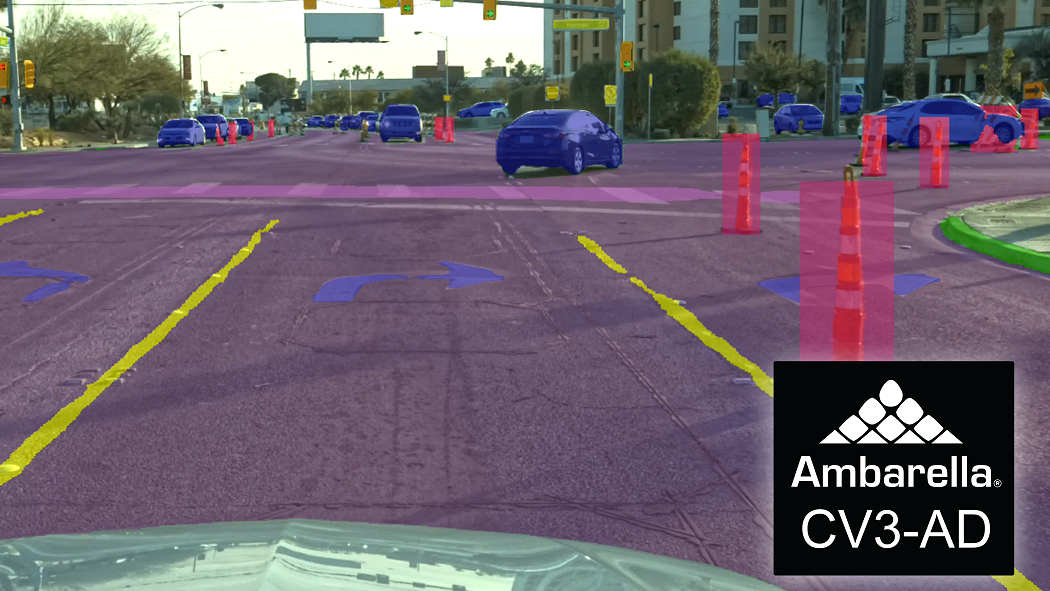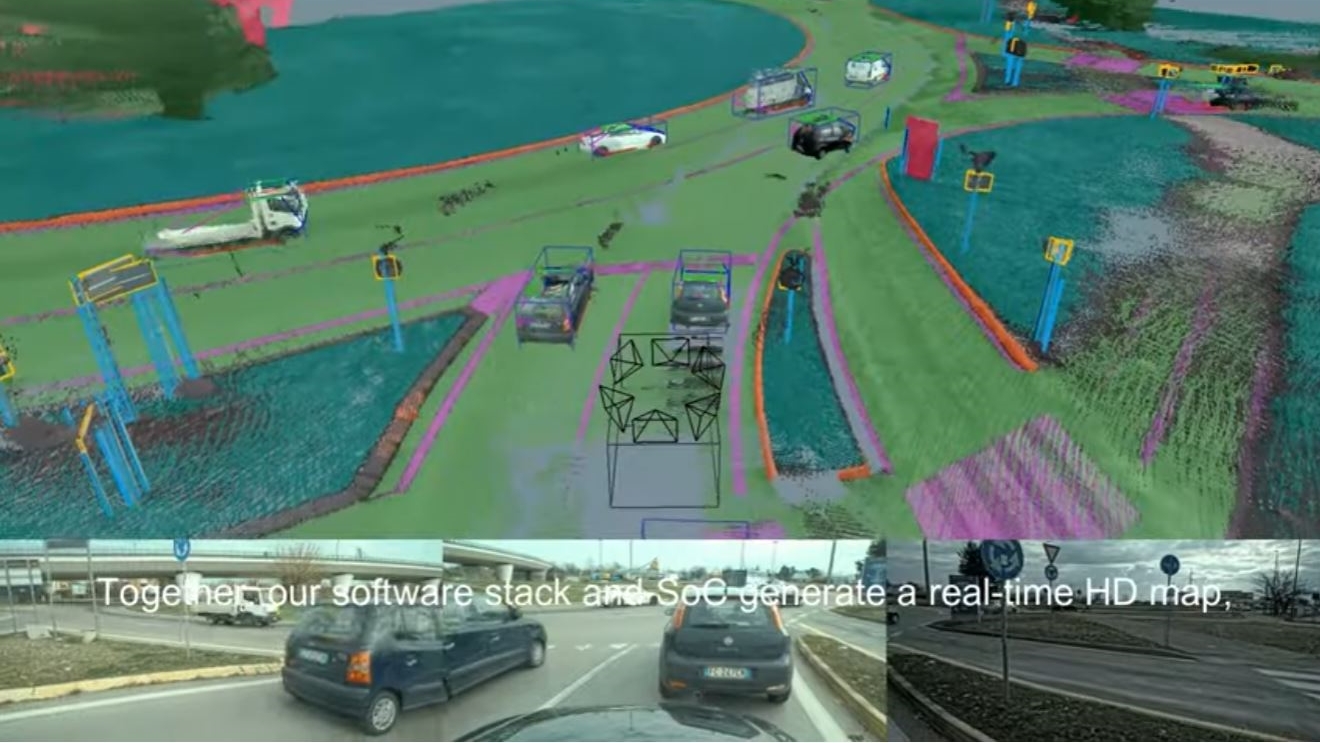성장하고 있는 전기차(EV) 시장에서 배터리 주행거리를 ??늘리기 위해서는 처리 효율성이 특히 중요합니다. 외부 및 내부 카메라 기반 인지 기능이 필수적인 가운데 AI 프로세싱에 소요되는 에너지를 저감하고 성능은 높이는 소프트웨어·AI 모듈 풀 스택이 자율주행 시장을 노리고 있다.

▲암바렐라 자율주행 소프트웨어 스택(Ambarella AD Software Stack / 사진:암바렐라)
환경인식·센서융합·모듈 풀스택 제공
CV3-AD AI 도메인 컨트롤러 SoC
성장하고 있는 전기차(EV) 시장에서 배터리 주행거리를 늘리기 위해서는 처리 효율성이 특히 중요합니다. 외부 및 내부 카메라 기반 인지 기능이 필수적인 가운데 AI 프로세싱에 소요되는 에너지를 저감하고 성능은 높이는 소프트웨어·AI 모듈 풀 스택이 자율주행 시장을 노리고 있다.
엣지 AI 반도체 제조기업 암바렐라(Ambarella)가 현지시간 12일 딥 러닝 AI 프로세싱 기반의 자율주행(AD) 소프트웨어 스택을 발표했다.
이번에 새로 출시한 솔루션은 △환경 인식 △센서 융합 △차량 경로 계획 등의 모듈식 컴포넌트를 포함한다.
최신 자율주행 스택과 암바렐라의 CV3-AD AI 도메인 컨트롤러 SoC 제품군은 함께 설계됐으며, 스택은 SoC의 CVflow AI 엔진에서 실행된다. Arm 코어에서 실행되는 칩은 전력 소비와 처리 부하를 최소화할 것으로 보인다.
마찬가지로 이러한 SoC는 감지 방식에 대한 지식과 경험을 바탕으로 비전, 레이더 감지 및 융합에 필요한 프로세싱을 제공한다. 또한 암바렐라의 스택은 구현 모델의 유연성을 제공하므로 자동차 OEM이 자체 소프트웨어 IP와 결합해 모듈의 일부 또는 전부를 활용할 수 있다.
페르미 왕 암바렐라 CEO는 “최신 AI SoC를 활용하기 위해 AD 스택이 꾸준히 발전해 온 VisLab 자동차 R&D 팀의 유산을 바탕으로 25년 이상의 경험을 바탕으로 이번 AD 스택이 구축됐다”라며 “현재 우리는 2015년 VisLab 인수의 비전을 실현하고 있으며 이 비전은 특수 목적 SoC 설계를 위한 알고리즘 우선 철학과 결합해 자동차 제조업체가 자율 주행에 대한 약속을 이행할 수 있게 해주는 플랫폼이 됐다”고 덧붙였다.
암바렐라의 AI 기반 소프트웨어 스택 특징 중 하나는 딥 러닝 기반 플래너이다. 이 동적 차량 경로 계획 모듈은 자연스러운 운전 경험을 가능하게 한다. 이를 통해 ‘딥 플래너’ 모듈을 다양한 실제 시나리오의 데이터로 학습시킬 수 있다.
R&D 차량의 최신 구성에는 모노 및 스테레오 카메라가 탑재된 감지 제품군과 암바렐라 Oculii 4D 이미징 레이더가 포함된다. 모든 프로세싱은 CV3-AD에 의해 수행된다. 다년간의 AD 및 센서 처리 경험을 통해 이러한 최적의 구성이 가능해졌지만 해당 솔루션은 OEM의 특정 감지 제품군을 LiDAR 추가 옵션을 포함해 유연하게 지원할 수 있다고 강조했다.
소프트웨어 스택의 주요 특징으로써 표준 화질(SD) 지도만 필요하다는 것이다. 사전 생성된 고화질(HD) 지도가 필요하지 않으며 다만 CV3-AD에서 실행되는 스택은 차량 감지 제품군의 실시간 환경 데이터를 사용해 실시간으로 HD 지도를 생성한다.

▲암바렐라 리얼타임 3D 맵(캡처:암바렐라 유튜브 채널)
대조적으로, 다른 AD 시스템에서 사용되는 사전 생성된 HD 맵은 깨지기 쉽고 유지 관리 비용이 많이 들기 때문에 센티미터 수준의 위치 파악 기능이 필요하다. 또한 도로 건설이나 사고와 같은 역동적인 상황에서도 신뢰성이 저하된다.
암바렐라의 실시간 HD 지도 생성은 △원형 교차로가 있는 대도시의 도심 지역 △주차된 차량이 있는 좁은 도로 △교통량이 많은 곳△건설 현장 △보행자 밀도가 높은 곳 △자전거 이용자 △기타 취약한 도로 등 어려운 AD 시나리오를 처리하는 데 이상적일 수 있다.
모듈식 AD 소프트웨어 및 하드웨어 솔루션은 OEM에 차량의 각 모델의 성능과 기능이 올바르게 조합된 CV3-AD 제품군 구성원을 선택할 수 있는 확장 가능한 플랫폼을 제공해 대중 시장 차량에서 자율 기능의 확장을 도모한다.
여기에는 완전한 기능을 갖춘 L2+ 시스템부터 더 높은 수준의 자율성에 이르기까지 광범위한 자율 및 반자율 차량 구현이 포함된다고 암바렐라는 강조했다.
암바렐라가 강조하는 바는 CV3-AD SoC는 낮은 전력 소비로 전체 AD 스택을 실행해 와트당 우수한 AI 성능을 제공하고 열 관리를 단순화하는 데 있다. 성장하고 있는 전기차(EV) 시장에서 배터리 주행거리를 늘리기 위해서는 처리 효율성이 특히 중요하기 때문이다.
또한 이 소프트웨어와 하드웨어는 CV3-AD의 Arm 처리 능력 중 극히 일부만 사용해 스택을 동작하기 때문에 최적 상호 작동이 가능한 설계이다. 이에 자동차 제조업체는 추가 소프트웨어를 통합해 기능 안전을 포함한 차별화된 기능을 생성할 수 있는 충분한 여유 공간이 있는 것으로 전해졌다.
암바렐라는 최적화된 AD 소프트웨어 및 하드웨어 솔루션 외에도 자동차 OEM에 사내 및 에코시스템 파트너 모두의 공급망과 생태계를 제공한다. 여기에는 CV3-AD의 온칩 인코더를 포함한 데이터 수집, 시뮬레이션 및 주석을 위한 맞춤형 도구가 포함된다. CV3-AD PCIe 서버 카드를 사용한 가속화된 SIL(software-in-the-loop) 시뮬레이션을 통해 개발이 간소화되며, 암바렐라는 AI 교육을 지원하기 위해 자동화된 3D 주석 파이프라인도 제공한다.
새로운 암바렐라 AD 소프트웨어 스택은 라스베이거스에서 열리는 CES 기간 동안 초대 전용 전시회에서 완전 자율 테스트 드라이브를 통해 시연될 예정이다.
